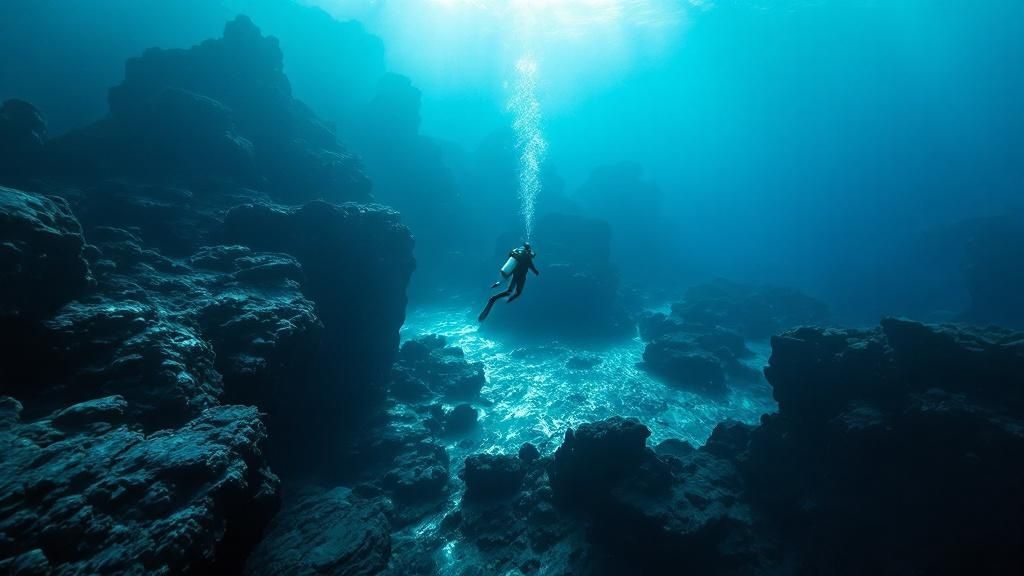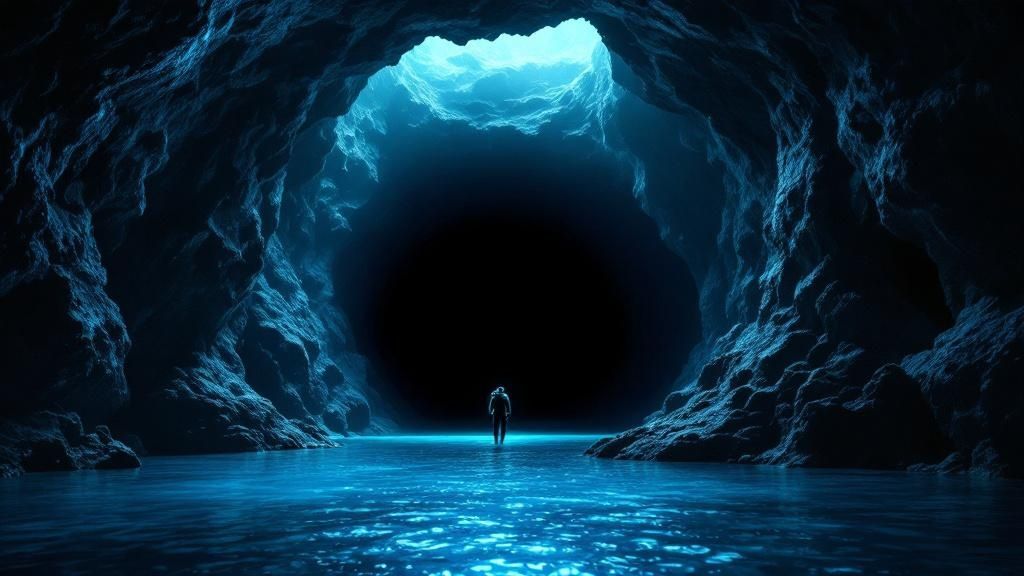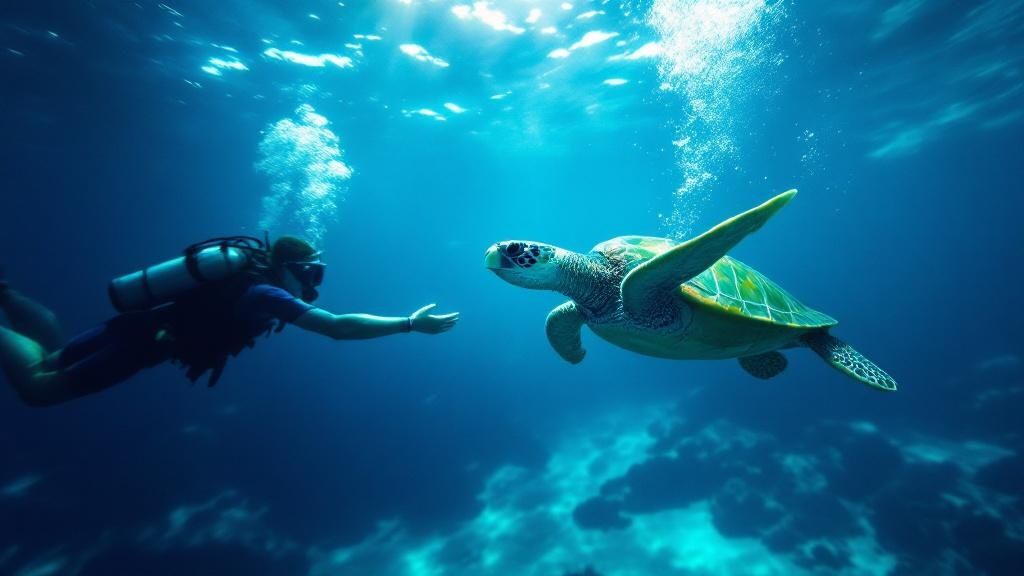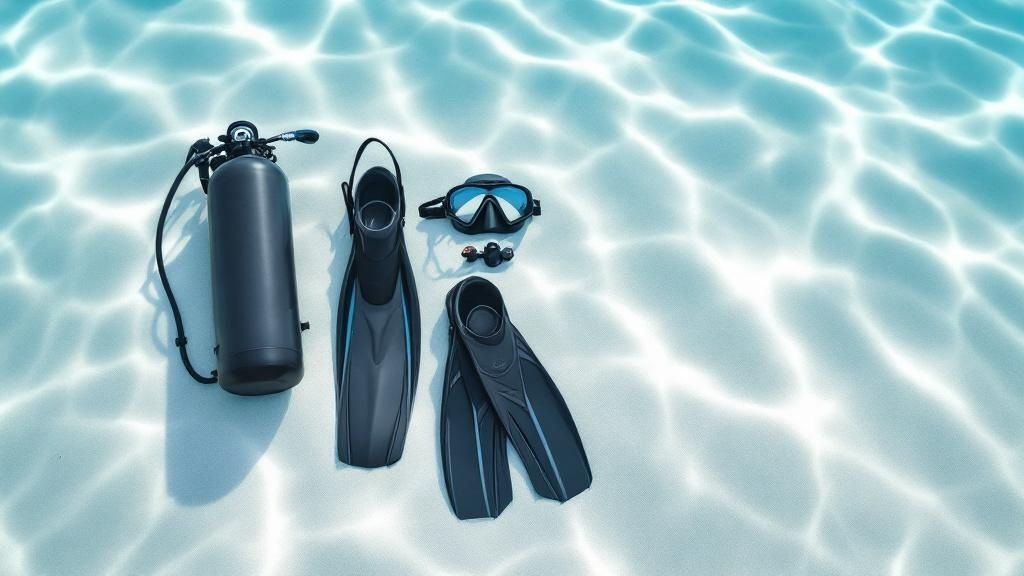Picture this: you're slowly descending into warm, impossibly clear water, watching as ancient volcanic rock formations give way to a bustling city of vibrant marine life. This is the heart of Big Island scuba diving, an experience that rightfully earns its place among the best in the world. The island, especially its famed Kona coast, is an underwater paradise that calls to divers of every skill level.
Why Is the Big Island a Top Diving Destination?

The Big Island's stellar reputation as a dive mecca is no accident—it's a direct result of its unique geology and the thriving ecosystems it supports. The island's colossal volcanoes, Mauna Loa and Mauna Kea, act as massive natural barriers, shielding the western Kona coast from powerful trade winds. The result? Incredibly calm and clear seas, where visibility often pushes past 100 feet.
This natural protection makes diving Big Island a fantastic year-round adventure. While other top-tier destinations are at the mercy of seasonal weather, Kona's leeward coast offers consistently great conditions. The underwater world here is a mirror of the volcanic landscape above ground, featuring dramatic lava tubes, ancient caverns, and submerged craters that are a dream for any underwater explorer.
A Hub for Underwater Adventure
The secret has been out for a while, and the popularity of scuba diving Big Island Hawaii has skyrocketed since the 1970s. Today, the island welcomes over 150,000 dive tourists each year, who log roughly 100,000 certified dives. With more than 50 professional Kona diving companies and charters to choose from, the opportunities for exploration are nearly limitless. You can get a deeper look into the vibrant dive industry on the Big Island here.
But what truly makes Kona diving special is the sheer biodiversity. The volcanic terrain has sculpted countless unique habitats, creating a home for a stunning variety of marine creatures. From the world-famous manta ray night dive to chance encounters with sea turtles, dolphins, and hundreds of species of tropical fish, every single dive promises a new discovery. This is what makes diving Hawaii Big Island an absolute must for anyone who loves the ocean.
Whether you're about to take your first breath underwater or you're a seasoned diver with a logbook full of adventures, the scuba Big Island experience has something incredible in store for you. It’s that one-of-a-kind mix of calm water, unique underwater architecture, and amazing marine life that makes it a truly world-class diving destination.
To truly understand what makes Big Island diving so special, it helps to see the key features at a glance.
Big Island Diving At A Glance
| Feature | Description |
|---|---|
| Calm Waters | The Kona coast is shielded by massive volcanoes, resulting in exceptionally calm and protected sea conditions year-round. |
| Excellent Visibility | Divers can regularly enjoy visibility exceeding 100 feet, making it easy to spot marine life and appreciate the underwater scenery. |
| Volcanic Topography | Explore unique underwater landscapes you won't find anywhere else, including lava tubes, arches, and ancient caverns. |
| Rich Biodiversity | The island is a hotspot for marine life, famous for its manta rays, sea turtles, dolphins, and endemic Hawaiian fish species. |
| Iconic Night Dives | Home to the world-renowned Manta Ray Night Dive, an unforgettable experience often called the best night dive on the planet. |
| Year-Round Diving | Consistent conditions mean you can plan a dive trip any month of the year and have a fantastic time. |
This combination of factors is why divers from all over the globe flock to the Big Island. Ready to see it for yourself? An unforgettable underwater adventure is waiting for you.
Discover the Best Big Island Dive Sites

If you're looking for the heart of Big Island scuba diving, you'll find it along the legendary Kona coast. This is where the real magic happens. Ancient underwater lava formations have sculpted a true diver's playground, with each site offering a completely different experience. You might find a calm, historic bay on one dive and a dramatic volcanic drop-off on the next.
Getting to know these locations is the first step in planning an unforgettable Kona diving adventure. Think of the coast as a string of incredible underwater parks, each with its own personality. Some are perfect for beginners, with clear, shallow waters, while others offer thrilling challenges for seasoned divers with their intricate lava tubes and deep canyons. This incredible variety is what keeps people coming back for more.
Kealakekua Bay: An Underwater Sanctuary
Kealakekua Bay isn't just another dive spot—it's a protected marine sanctuary and a place steeped in Hawaiian history. Its waters are calm and incredibly clear, sheltered from the open ocean, which makes it a fantastic and relaxing dive for any skill level.
As soon as you descend, you'll see vibrant coral gardens sloping gently away from the shore, creating a perfect habitat for a stunning amount of fish life. The sheer biodiversity here is proof of what happens when an area is properly protected.
Big Island scuba diving puts you face-to-face with an ecosystem forged by volcanoes. Legendary sites like Kealakekua Bay are teeming with over 200 species of fish. Other must-see spots like Two Step and Pawai Bay are right behind, hosting around 180 and 150 marine species respectively.
Two Step: Easy Access to Abundant Life
Affectionately named for its ridiculously easy entry point—two natural lava rock "steps" that lead you right into the ocean—Two Step is a local favorite. Located at Honaunau Bay, its accessibility makes it a top choice for divers and snorkelers who want to get in the water fast without needing a boat.
The second you're underwater, you’re greeted by a lively reef. It’s almost guaranteed you'll see Hawaiian green sea turtles (honu) resting among the corals or gliding by. Spinner dolphins are also regular visitors to the bay, and if you’re lucky, they'll put on one of their famous aerial shows. While it’s a great shore dive, taking a charter boat allows you to explore the less-visited outer reef. If you love the idea of gearing up and walking right in, you should check out our guide to the best shore diving on the Big Island.
Pawai Bay: Volcanic Drama Underwater
If you’re craving a dive with a bit more drama, Pawai Bay is your spot. This boat-access-only site is a perfect example of the wild topography that makes scuba Big Island so special. You'll navigate a maze of arches, lava tubes, and swim-throughs carved out by ancient lava flows.
This complex structure is a paradise for marine life that loves to hide. Keep an eye out for moray eels, octopuses, and all sorts of crustaceans tucked into the countless nooks and crannies. The crown jewel for many divers here is the "dome," a massive, submerged volcanic crater that makes for a truly unforgettable dive. It's a fantastic site for divers who are confident in their skills and ready to explore something truly unique.
Experience the Manta Ray Night Dive Ballet

Get ready for an experience that consistently tops the list of the world's most incredible underwater encounters. The manta ray night dive is the signature event for Big Island diving, a spectacle so captivating it's often called a weightless, underwater ballet. It’s an adventure that truly defines scuba diving Big Island and leaves every person who witnesses it speechless.
The magic behind this dive is brilliantly simple. After sunset, dive operators set up powerful underwater lights on the seafloor. These lights attract massive clouds of plankton, the manta rays' primary food source. What happens next is a performance you’ll never forget.
Majestic manta rays, with wingspans reaching over 12 feet, swoop, glide, and perform effortless barrel rolls through the light beams. They feed on the plankton buffet just inches from your face, creating a safe but profoundly moving encounter. As you kneel on the sandy bottom, you have a front-row seat to one of nature’s most graceful shows.
The Science Behind the Spectacle
This nightly gathering isn't just a happy accident; it's a learned behavior. Over the years, the manta rays along the Kona coast have come to associate the bright lights with an easy, all-you-can-eat meal. This unique relationship between Kona diving companies and the local manta population has created a reliable and world-famous attraction.
The entire process is carefully managed to be thrilling for divers and, most importantly, safe for the mantas. Here’s a quick rundown of how it works:
- The Setup: Your guide leads you to a designated spot, sometimes called a "campfire," where bright lights are placed on the ocean floor, all pointing up toward the surface.
- The Attraction: The beams of light create a massive, glowing column in the dark water, which acts like a magnet for phytoplankton.
- The Arrival: The local reef mantas, drawn by the irresistible concentration of food, show up for their nightly ballet.
This amazing interaction turns the dark ocean into a breathtaking stage. For a more detailed breakdown, you can learn more about what makes the manta ray night dive so special.
The key to this experience is respect. Manta rays are protected by a thin layer of mucus that shields them from infection. Touching them can be harmful. The rule is simple: look, but don't touch. Let these magnificent creatures orchestrate the show.
Safety and Respectful Interaction
Ensuring the long-term health and safety of the manta ray population is the absolute top priority for every responsible operator. This is a passive experience—divers are observers, not participants. You simply settle on the bottom and watch the spectacle unfold above and around you.
This hands-off approach ensures the animals are never stressed and can feed naturally. Reputable companies follow strict guidelines, like maintaining a safe distance and positioning divers to give the mantas plenty of room to move. It’s a perfect model of eco-tourism, allowing you to witness a natural wonder while contributing to its preservation. To see just how magical it is, you can dive into the underwater night ballet with Kona's manta rays.
Honestly, your diving Big Island adventure just isn't complete without it.
How to Choose the Right Dive Company and Courses

Picking the right operator can turn a good Big Island scuba diving trip into the adventure of a lifetime. The quality of your guide, the crew's commitment to safety, and the overall vibe of the experience all come down to the company you choose. And with so many Kona diving companies out there, it really pays to know what to look for.
Think of your dive boat as more than just transportation—it's your basecamp on the water. Your guide isn't just someone showing you the way; they're your underwater interpreter and your first line of defense. Making the right choice from the start is key to having a spectacular and safe time beneath the waves.
Evaluating Kona Diving Companies
When you start planning your diving Big Island adventure, the first real step is to vet the local operators. Don't just get pulled in by a flashy website. Instead, focus on the fundamentals that make for a truly great day on (and in) the water. Safety should be your top priority, so look for companies that are open and clear about their safety protocols and emergency plans.
A huge indicator of a quality operation is the experience of its crew. Seasoned divemasters and instructors who know the local sites like the back of their hand can lead you to incredible hidden spots and point out marine life you'd almost certainly miss on your own. It's that deep, local knowledge that turns a standard dive into something truly memorable.
A company's commitment to the ocean itself is a massive green flag. Operators who are actively involved in conservation efforts and stick to eco-friendly guidelines—especially for sensitive dives like the manta ray night dive—aren't just running a business. They're protecting the very reason diving Hawaii Big Island is so special in the first place.
To get a head start, you can explore detailed breakdowns and comparisons of your options. For a comprehensive look at the best operators on the island, check out our guide on the top 10 Kona diving companies ranked.
Finding the Perfect Dive Course for You
Your scuba Big Island journey doesn’t have to end with guided tours. Whether you've never breathed through a regulator before or you're a seasoned diver looking to sharpen your skills, there’s a course that’s perfect for you.
-
For Beginners: The Discover Scuba Diving (DSD) Experience: Curious about the underwater world but not quite ready for a full certification course? The DSD is your answer. It’s a one-day, fully supervised dive with an instructor that gives you a real taste of scuba diving Big Island Hawaii without the commitment of a multi-day class.
-
For Aspiring Divers: The Open Water Certification: This is your official passport to the underwater world. A full PADI or SSI Open Water course provides all the essential skills and knowledge you need to dive safely and confidently, anywhere on the globe.
-
For Certified Divers: Advanced Open Water and Specialties: Ready to take the next step? The Advanced Open Water course builds on your foundation, introducing you to new challenges like deep diving and underwater navigation. You can also dive into specialty courses, like Night Diver (a must for the manta experience!) or Peak Performance Buoyancy, to really dial in your skills.
Choosing the right course will unlock a whole new level of Kona diving and open up a world of possibilities for all your future adventures.
Planning Your Ultimate Big Island Dive Trip
A truly unforgettable Big Island scuba diving trip begins long before you touch down in Hawaii. Proper planning is the secret sauce to a smooth, stress-free adventure. Getting the logistics sorted out ahead of time means that once you’re here, your only job is to soak in the incredible underwater world waiting for you. This guide will walk you through everything you need to know.
First things first: when should you come? The great news is that diving the Big Island is phenomenal all year round, especially since the Kona coast is naturally shielded from the harsher trade winds. That said, different seasons bring their own unique flavor to the experience. Choosing the right time really boils down to what you want to get out of your diving Hawaii Big Island vacation.
Choosing the Best Time for Your Dive Trip
Deciding when to dive Kona involves a simple trade-off: do you prefer warmer water or the chance for a truly unique acoustic experience? Your ideal time to visit will depend on which one you value more.
-
Summer (May – October): This is prime time for many divers. You'll get the warmest water, usually a balmy 78-80°F (25-27°C), and the calmest surface conditions. If you're someone who gets chilled easily or just wants maximum comfort, this is your season.
-
Winter (November – April): While the water dips slightly to a still-comfortable 75-77°F (24-25°C), winter brings its own magic. This is humpback whale season. You won’t see them on your dive, but you’ll often hear them—their beautiful, haunting songs provide an unforgettable soundtrack to your scuba diving Big Island Hawaii adventure.
No matter which season you pick, you'll be rewarded with incredible visibility, often clearing 100 feet. You really can’t go wrong.
And what about the mantas? Great news—they live here! Unlike migratory species, Kona's manta rays are year-round residents. This means the world-famous manta ray night dive is a spectacular and reliable show any night of the year.
Deciding when to come is the hardest part. Now let's look at seasonal conditions at a glance.
Seasonal Diving Conditions in Kona
This table breaks down what you can generally expect throughout the year, helping you pinpoint the perfect season for your dive trip.
| Season | Water Temperature (Approx.) | Visibility | Key Marine Life Sightings |
|---|---|---|---|
| Summer (May-Oct) | 78-80°F (25-27°C) | Excellent (often 100+ ft) | Manta Rays, Turtles, Dolphins, large schools of reef fish. |
| Winter (Nov-Apr) | 75-77°F (24-25°C) | Excellent (often 100+ ft) | Manta Rays, Turtles, Humpback whale songs (audible underwater). |
Ultimately, there’s no bad time to dive in Kona. The conditions are consistently world-class, so your choice just comes down to personal preference.
Gear, Accommodations, and Safety
With your dates circled on the calendar, let's talk logistics. A common question is what to pack versus what to rent. Many divers find that bringing their own mask, fins, and dive computer is best for comfort and familiarity. For bulkier items, renting a high-quality, well-maintained BCD and regulator from a top-tier Kona diving company like Kona Honu Divers saves a ton of luggage space and hassle.
Where you stay also makes a big difference. For sheer convenience, staying in or near Kailua-Kona is the way to go. It's the central hub for almost all dive boats and shops. To make it easier, we've put together a guide on the best places for divers to stay on the Big Island.
Finally, never forget that safety comes first. While Kona diving is known for its gentle conditions, always pay close attention to dive briefings, be aware of any local currents, and respect our precious marine life. A well-planned trip is a safe trip, which frees you up to enjoy the magic of the Big Island's underwater realm.
Frequently Asked Questions About Big Island Diving
It's only natural to have a few questions before diving into a new spot. Whether you've logged hundreds of dives or are just starting to think about exploring the world beneath the waves, we've got you covered. Here are the answers to the questions we hear most often about scuba diving Big Island Hawaii.
Let’s get these cleared up so you can plan your underwater adventure with total confidence.
Is there good diving on the Big Island?
Good is an understatement! The Big Island diving experience, especially on the Kona coast, is considered world-class. You get amazing visibility, calm seas protected from trade winds, and a one-of-a-kind underwater landscape of lava tubes and craters, not to mention the legendary manta ray night dive.
What are the best months to scuba dive in Hawaii?
You can have a great dive any time of year, but the summer months (May to October) usually offer the warmest water and flattest seas. The trade-off is winter (November to April), when the water is a bit cooler but you might get to hear humpback whale songs echoing through the water on your dive.
Is Kona good for scuba diving?
Kona is the place for scuba diving Big Island. Its west-facing shoreline is sheltered from the winds, creating those calm, clear conditions divers dream of. The vast majority of the island's best dive sites and charter boats are based right here.
Is it better to snorkel or scuba dive in Hawaii?
It really depends on the experience you're after. Snorkeling is easy, accessible, and perfect for peeking at the vibrant life on shallow reefs. But if you want to explore deeper, glide through lava tubes, and see a different class of marine life, you have to scuba dive. For truly immersive experiences like the manta ray night dive, scuba is the only way to go.
Which Hawaiian island is best for scuba diving?
While every island has something to offer, most experienced divers will tell you the Big Island is the top choice. The combination of Kona's protected coast, incredible volcanic formations, and iconic dives like the manta ray experience puts it in a league of its own for diving Hawaii Big Island.
When to dive Kona?
Any time is a good time to dive Kona! Summer (May-October) brings the warmest water and calmest conditions, making it a popular choice. Winter is fantastic too, offering a slightly different experience with cooler water but the magical soundtrack of humpback whales.
